4D Models Generated with UAV Photogrammetry for Landfill Monitoring Thermal Control of Municipal Solid Waste (MSW) Landfills
Abstract
:1. Introduction
2. Methods
2.1. Data and Thermal Imaging Capture with Low-Cost UAVs
2.2. Photogrammetric Processing of RGB and TIR Images
2.3. D Thermal Model Calibration
2.4. Photointerpretation Analysis of Thermal Orthomosaics with GIS
3. Method Validation
3.1. Study Area
3.2. UAV Photogrammetric Flight
4. Results
4.1. 4D Thermal Model Generation
4.2. GIS Analysis for Hot Spot Identification
4.3. Validation of Results
5. Discussion
6. Conclusions
Author Contributions
Funding
Institutional Review Board Statement
Informed Consent Statement
Data Availability Statement
Acknowledgments
Conflicts of Interest
References
- Tanda, G.; Balsi, M.; Fallavollita, P.; Chiarabini, V. A Uav-Based Thermal-Imaging Approach for the Monitoring of Urban Landfills. Inventions 2020, 5, 55. [Google Scholar] [CrossRef]
- Jovanov, D.; Vujić, B.; Vujić, G. Optimization of the Monitoring of Landfill Gas and Leachate in Closed Methanogenic Landfills. J. Environ. Manag. 2018, 216, 32–40. [Google Scholar] [CrossRef] [PubMed]
- Yan, W.Y.; Mahendrarajah, P.; Shaker, A.; Faisal, K.; Luong, R.; Al-Ahmad, M. Analysis of Multi-Temporal Landsat Satellite Images for Monitoring Land Surface Temperature of Municipal Solid Waste Disposal Sites. Environ. Monit. Assess. 2014, 186, 8161–8173. [Google Scholar] [CrossRef] [PubMed]
- Wyard, C.; Beaumont, B.; Grippa, T.; Hallot, E. UAV-Based Landfill Land Cover Mapping: Optimizing Data Acquisition and Open-Source Processing Protocols. Drones 2022, 6, 123. [Google Scholar] [CrossRef]
- Giusti, L. A Review of Waste Management Practices and Their Impact on Human Health. Waste Manag. 2009, 29, 2227–2239. [Google Scholar] [CrossRef] [PubMed]
- Battaglini, R.; Raco, B.; Scozzari, A. Effective Monitoring of Landfills: Flux Measurements and Thermography Enhance Efficiency and Reduce Environmental Impact. J. Geophys. Eng. 2013, 10, 064002. [Google Scholar] [CrossRef]
- Nair, A.T.; Senthilnathan, J.; Nagendra, S.M.S. Emerging Perspectives on VOC Emissions from Landfill Sites: Impact on Tropospheric Chemistry and Local Air Quality. Process Saf. Environ. Prot. 2019, 121, 143–154. [Google Scholar] [CrossRef]
- Hanson, J.L.; Yeşiller, N.; Oettle, N.K. Spatial and Temporal Temperature Distributions in Municipal Solid Waste Landfills. J. Environ. Eng. 2010, 136, 804–814. [Google Scholar] [CrossRef]
- Jafari, N.H.; Stark, T.D.; Thalhamer, T. Progression of Elevated Temperatures in Municipal Solid Waste Landfills. J. Geotech. Geoenvironmental Eng. 2017, 143, 05017004. [Google Scholar] [CrossRef]
- Sabrin, S.; Nazari, R.; Fahad, M.G.R.; Karimi, M.; Everett, J.W.; Peters, R.W. Investigating Effects of Landfill Soil Gases on Landfill Elevated Subsurface Temperature. Appl. Sci. 2020, 10, 6401. [Google Scholar] [CrossRef]
- Koerner, G.R.; Koerner, R.M. Long-Term Temperature Monitoring of Geomembranes at Dry and Wet Landfills. Geotext. Geomembr. 2006, 24, 72–77. [Google Scholar] [CrossRef]
- Emmi, G.; Zarrella, A.; Zuanetti, A.; De Carli, M. Use of Municipal Solid Waste Landfill as Heat Source of Heat Pump. Energy Procedia 2016, 101, 352–359. [Google Scholar] [CrossRef]
- Lewis, A.W.; Yuen, S.T.S.; Smith, A.J.R. Detection of Gas Leakage from Landfills Using Infrared Thermography—Applicability and Limitations. Waste Manag. Res. 2003, 21, 436–447. [Google Scholar] [CrossRef] [PubMed]
- Kim, Y.M.; Park, M.H.; Jeong, S.; Lee, K.H.; Kim, J.Y. Evaluation of Error Inducing Factors in Unmanned Aerial Vehicle Mounted Detector to Measure Fugitive Methane from Solid Waste Landfill. Waste Manag. 2021, 124, 368–376. [Google Scholar] [CrossRef] [PubMed]
- Kane, S.N.; Mishra, A.; Dutta, A.K. Application of Close-Range Aerial Infrared Thermography to Detect Landfill Gas Emissions: A Case Study. J. Phys. Conf. Ser. 2016, 755, 011001. [Google Scholar] [CrossRef]
- Kwarteng, A.; Al-Enezi, A. Assessment of Kuwait’s Al-Qurain Landfill Using Remotely Sensed Data. J. Environ. Sci. Health 2011, 39, 351–364. [Google Scholar] [CrossRef] [PubMed]
- Jafari, N.H.; Stark, T.D.; Roper, R. Classification and Reactivity of Secondary Aluminum Production Waste. J. Hazard. Toxic Radioact. Waste 2014, 18, 04014018. [Google Scholar] [CrossRef]
- Frid, V.; Doudkinski, D.; Liskevich, G.; Shafran, E.; Averbakh, A.; Korostishevsky, N.; Prihodko, L. Geophysical-Geochemical Investigation of Fire-Prone Landfills. Environ. Earth Sci. 2010, 60, 787–798. [Google Scholar] [CrossRef]
- Lega, M.; Napoli, R.M.A. A New Approach to Solid Waste Landfills Aerial Monitoring. WIT Trans. Ecol. Environ. 2008, 109, 193–199. [Google Scholar] [CrossRef]
- Martin, J.W.; Stark, T.D.; Thalhamer, T.; Gerbasi-Graf, G.T.; Gortner, R.E. Detection of Aluminum Waste Reactions and Waste Fires. J. Hazard. Toxic Radioact. Waste 2013, 17, 164–174. [Google Scholar] [CrossRef]
- Zuberi, M.J.S.; Ali, S.F. Greenhouse Effect Reduction by Recovering Energy from Waste Landfills in Pakistan. Renew. Sustain. Energy Rev. 2015, 44, 117–131. [Google Scholar] [CrossRef]
- Allen, G.; Hollingsworth, P.; Kabbabe, K.; Pitt, J.R.; Mead, M.I.; Illingworth, S.; Roberts, G.; Bourn, M.; Shallcross, D.E.; Percival, C.J. The Development and Trial of an Unmanned Aerial System for the Measurement of Methane Flux from Landfill and Greenhouse Gas Emission Hotspots. Waste Manag. 2019, 87, 883–892. [Google Scholar] [CrossRef] [PubMed]
- Lavoie, T.N.; Shepson, P.B.; Cambaliza, M.O.L.; Stirm, B.H.; Karion, A.; Sweeney, C.; Yacovitch, T.I.; Herndon, S.C.; Lan, X.; Lyon, D. Aircraft-Based Measurements of Point Source Methane Emissions in the Barnett Shale Basin. Environ. Sci. Technol. 2015, 49, 7904–7913. [Google Scholar] [CrossRef] [PubMed]
- Battulwar, R.; Winkelmaier, G.; Valencia, J.; Naghadehi, M.Z.; Peik, B.; Abbasi, B.; Parvin, B.; Sattarvand, J. A Practical Methodology for Generating High-Resolution 3D Models of Open-Pit Slopes Using UAVs: Flight Path Planning and Optimization. Remote Sens. 2020, 12, 2283. [Google Scholar] [CrossRef]
- Sliusar, N.; Filkin, T.; Huber-Humer, M.; Ritzkowski, M. Drone Technology in Municipal Solid Waste Management and Landfilling: A Comprehensive Review. Waste Manag. 2022, 139, 1–16. [Google Scholar] [CrossRef] [PubMed]
- Guimarães, C.C.; Barbosa, A.M.; Gandolfo, O.C.B. Visual Interpretation of Satellite and Aerial Images to Identify and Study the Evolution of Inadequate Urban Waste Disposal Sites. Detritus 2019, 6, 85–95. [Google Scholar] [CrossRef]
- Incekara, A.H.; Delen, A.; Seker, D.Z.; Goksel, C. Investigating the Utility Potential of Low-Cost Unmanned Aerial Vehicles in the Temporal Monitoring of a Landfill. ISPRS Int. J. Geo-Inf. 2019, 8, 22. [Google Scholar] [CrossRef]
- Azimov, O.; Schevchuk, O.; Azimova, K.; Dorofey, Y.; Tomchenko, O. Integration of GIS and RSE Aiming to the Effective Monitoring of the Surroundings of Landfills. Ukr. J. Remote Sens. 2020, 27, 4–12. [Google Scholar] [CrossRef]
- Daugela, I.; Visockiene, J.S.; Kumpiene, J. Detection and Analysis of Methane Emissions from a Landfill Using Unmanned Aerial Drone Systems and Semiconductor Sensors. Detritus 2020, 10, 127–138. [Google Scholar] [CrossRef]
- Messinger, M.; Silman, M. Unmanned Aerial Vehicles for the Assessment and Monitoring of Environmental Contamination: An Example from Coal Ash Spills. Environ. Pollut. 2016, 218, 889–894. [Google Scholar] [CrossRef]
- Tomaštík, J.; Mokroš, M.; Surový, P.; Grznárová, A.; Merganič, J. UAV RTK/PPK Method-An Optimal Solution for Mapping Inaccessible Forested Areas? Remote Sens. 2019, 11, 721. [Google Scholar] [CrossRef]
- Ngoc Qui, B.; Dinh Hien, L.; Quoc Long, N.; Si Son, T.; Anh Quan, D.; Van Hiep, P.; Thanh Hai, P.; Thi Lan, P. Method of Defining the Parameters for UAV Point Cloud Classification Algorithm. Inz. Miner. 2020, 1, 49–56. [Google Scholar] [CrossRef]
- Pérez-Álvarez, R.; Sedano-cibrián, J.; de Luis-Ruiz, J.M.; Fernández-Maroto, G. Mining Exploration with UAV, Low-Cost Thermal Cameras and GIS Tools—Application to the Specific Case of the Complex Sulfides Hosted in Carbonates of Udías (Cantabria, Spain). Minerals 2022, 12, 140. [Google Scholar] [CrossRef]
- Chaudhry, M.H.; Ahmad, A.; Gulzar, Q. Impact of UAV Surveying Parameters on Mixed Urban Landuse Surface Modelling. ISPRS Int. J. Geo-Inf. 2020, 9, 656. [Google Scholar] [CrossRef]
- Nazari, R.; Alfergani, H.; Haas, F.; Karimi, M.E.; Fahad, M.G.R.; Sabrin, S.; Everett, J.; Bouaynaya, N.; Peters, R.W. Application of Satellite Remote Sensing in Monitoring Elevated Internal Temperatures of Landfills. Appl. Sci. 2020, 10, 6801. [Google Scholar] [CrossRef]
- Emran, B.J.; Tannant, D.D.; Najjaran, H. Low-Altitude Aerial Methane Concentration Mapping. Remote Sens. 2017, 9, 823. [Google Scholar] [CrossRef]
- Fjelsted, L.; Christensen, A.G.; Larsen, J.E.; Kjeldsen, P.; Scheutz, C. Assessment of a Landfill Methane Emission Screening Method Using an Unmanned Aerial Vehicle Mounted Thermal Infrared Camera—A Field Study. Waste Manag. 2019, 87, 893–904. [Google Scholar] [CrossRef]
- Mønster, J.; Kjeldsen, P.; Scheutz, C. Methodologies for Measuring Fugitive Methane Emissions from Landfills—A Review. Waste Manag. 2019, 87, 835–859. [Google Scholar] [CrossRef]
- Muleya, M. Photogrammetry Based Analysis for the Risks Associated with Landfilling in Developing Countries: Case Study, Chunga Landfill; Auckland University of Technology: Lusaka, Zambia, 2020. [Google Scholar]
- Yeşiller, N.; Hanson, J.L.; Kopp, K.B.; Yee, E.H. Heat Management Strategies for MSW Landfills. Waste Manag. 2016, 56, 246–254. [Google Scholar] [CrossRef]
- Moon, D.; Chung, S.; Kwon, S.; Seo, J.; Shin, J. Comparison and Utilization of Point Cloud Generated from Photogrammetry and Laser Scanning: 3D World Model for Smart Heavy Equipment Planning. Autom. Constr. 2019, 98, 322–331. [Google Scholar] [CrossRef]
- de Luis-Ruiz, J.M.; Sedano-Cibrián, J.; Pereda-García, R.; Pérez-Álvarez, R.; Malagón-Picón, B. Optimization of Photogrammetric Flights with UAVs for the Metric Virtualization of Archaeological Sites. Application to Juliobriga (Cantabria, Spain). Appl. Sci. 2021, 11, 1204. [Google Scholar] [CrossRef]
- Mesas-Carrascosa, F.J.; Pérez-Porras, F.; de Larriva, J.E.M.; Frau, C.M.; Agüera-Vega, F.; Carvajal-Ramírez, F.; Martínez-Carricondo, P.; García-Ferrer, A. Drift Correction of Lightweight Microbolometer Thermal Sensors On-Board Unmanned Aerial Vehicles. Remote Sens. 2018, 10, 615. [Google Scholar] [CrossRef]
- de Luis-Ruiz, J.M.; Sedano-Cibrián, J.; Pérez-Álvarez, R.; Pereda-García, R.; Malagón-Picón, B. Metric Contrast of Thermal 3D Models of Large Industrial Facilities Obtained by Means of Low-Cost Infrared Sensors in UAV Platforms. Int. J. Remote Sens. 2021, 43, 457–483. [Google Scholar] [CrossRef]
- Tonkin, T.N.; Midgley, N.G. Ground-Control Networks for Image Based Surface Reconstruction: An Investigation of Optimum Survey Designs Using UAV Derived Imagery and Structure-from-Motion Photogrammetry. Remote Sens. 2016, 8, 786. [Google Scholar] [CrossRef]
- Maes, W.H.; Huete, A.R.; Steppe, K. Optimizing the Processing of UAV-Based Thermal Imagery. Remote Sens. 2017, 9, 476. [Google Scholar] [CrossRef]
- Koch, T.; Körner, M.; Fraundorfer, F. Automatic and Semantically-Aware 3D UAV Flight Planning for Image-Based 3D Reconstruction. Remote Sens. 2019, 11, 1550. [Google Scholar] [CrossRef]
- Pan, Y.; Dong, Y.; Wang, D.; Chen, A.; Ye, Z. Three-Dimensional Reconstruction of Structural Surface Model of Heritage Bridges Using UAV-Based Photogrammetric Point Clouds. Remote Sens. 2019, 11, 1204. [Google Scholar] [CrossRef]
- Nex, F.; Remondino, F. UAV for 3D Mapping Applications: A Review. Appl. Geomat. 2014, 6, 1–15. [Google Scholar] [CrossRef]
- Roca, D.; Lagüela, S.; Díaz-Vilariño, L.; Armesto, J.; Arias, P. Low-Cost Aerial Unit for Outdoor Inspection of Building Façades. Autom. Constr. 2013, 36, 128–135. [Google Scholar] [CrossRef]
- Lv, M.; Xiao, S.; Tang, Y.; He, Y. Influence of UAV Flight Speed on Droplet Deposition Characteristics with the Application of Infrared Thermal Imaging. Int. J. Agric. Biol. Eng. 2019, 12, 10–17. [Google Scholar] [CrossRef]
- Kelly, J.; Kljun, N.; Olsson, P.O.; Mihai, L.; Liljeblad, B.; Weslien, P.; Klemedtsson, L.; Eklundh, L. Challenges and Best Practices for Deriving Temperature Data from an Uncalibrated UAV Thermal Infrared Camera. Remote Sens. 2019, 11, 567. [Google Scholar] [CrossRef]
- Wan, Q.; Brede, B.; Smigaj, M.; Kooistra, L. Factors Influencing Temperature Measurements from Miniaturized Thermal Infrared (Tir) Cameras: A Laboratory-Based Approach. Sensors 2021, 21, 8466. [Google Scholar] [CrossRef] [PubMed]
- Kim, J.; Lee, S.; Seo, J.; Lee, D.E.; Choi, H.S. The Integration of Earthwork Design Review and Planning Using Uav-Based Point Cloud and Bim. Appl. Sci. 2021, 11, 3435. [Google Scholar] [CrossRef]
- Senkal, E.; Kaplan, G.; Avdan, U. Accuracy Assessment of Digital Surface Models From Unmanned Aerial Vehicles’ Imagery on Archaeological Sites. Int. J. Eng. Geosci. 2021, 6, 81–89. [Google Scholar] [CrossRef]
- Ferrer-González, E.; Agüera-Vega, F.; Carvajal-Ramírez, F.; Martínez-Carricondo, P. UAV Photogrammetry Accuracy Assessment for Corridor Mapping Based on the Number and Distribution of Ground Control Points. Remote Sens. 2020, 12, 2447. [Google Scholar] [CrossRef]
- Jin Yu, J.; Woo Kim, D.; Jung Lee, E.; Woo Son, S. Determining the Optimal Number of Ground Control Points for Varying Study Sites through Accuracy Evaluation of Unmanned Aerial System-Based 3d Point Clouds and Digital Surface Models. Drones 2020, 4, 49. [Google Scholar] [CrossRef]
- Silvestri, M.; Marotta, E.; Buongiorno, M.F.; Avvisati, G.; Belviso, P.; Sessa, E.B.; Caputo, T.; Longo, V.; De Leo, V.; Teggi, S. Monitoring of Surface Temperature on Parco Delle Biancane (Italian Geothermal Area) Using Optical Satellite Data, UAV and Field Campaigns. Remote Sens. 2020, 12, 2018. [Google Scholar] [CrossRef]
- Hartmann, W.; Tilch, S.; Eisenbeiss, H.; Schindler, K. Determination of the Uav Position By Automatic Processing of Thermal Images. Int. Arch. Photogramm. Remote Sens. Spat. Inf. Sci. 2012, XXXIX-B6, 111–116. [Google Scholar] [CrossRef]
- Hoegner, L.; Tuttas, S.; Xu, Y.; Eder, K.; Stilla, U. Evaluation of Methods for Coregistration and Fusion of RPAS-Based 3D Point Clouds and Thermal Infrared Images. Int. Arch. Photogramm. Remote Sens. Spat. Inf. Sci.-ISPRS Arch. 2016, 41, 241–246. [Google Scholar] [CrossRef]
- Maes, W.H.; Huete, A.R.; Avino, M.; Boer, M.M.; Dehaan, R.; Pendall, E.; Griebel, A.; Steppe, K. Can UAV-Based Infrared Thermography Be Used to Study Plant-Parasite Interactions between Mistletoe and Eucalypt Trees? Remote Sens. 2018, 10, 2062. [Google Scholar] [CrossRef]
- Daffara, C.; Muradore, R.; Piccinelli, N.; Gaburro, N.; de Rubeis, T.; Ambrosini, D. A Cost-Effective System for Aerial 3d Thermography of Buildings. J. Imaging 2020, 6, 76. [Google Scholar] [CrossRef] [PubMed]
- Yang, Y.; Lee, X. Four-Band Thermal Mosaicking: A New Method to Process Infrared Thermal Imagery of Urban Landscapes from UAV Flights. Remote Sens. 2019, 11, 1365. [Google Scholar] [CrossRef]
- Kapil, R.; Castilla, G.; Marvasti-Zadeh, S.M.; Goodsman, D.; Erbilgin, N.; Ray, N. Orthomosaicking Thermal Drone Images of Forests via Simultaneously Acquired RGB Images. Remote Sens. 2023, 15, 2653. [Google Scholar] [CrossRef]
- De Marco, J.; Maset, E.; Cucchiaro, S.; Beinat, A.; Cazorzi, F. Assessing Repeatability and Reproducibility of Structure-from-Motion Photogrammetry for 3d Terrain Mapping of Riverbeds. Remote Sens. 2021, 13, 2572. [Google Scholar] [CrossRef]
- Lapeña-Mañero, P.; García-Casuso, C.; Cañizal, J.; Sagaseta, C. Shear Strength Characterization of Fresh MBT and MSWI Wastes from a Spanish Treatment Facility. Waste Manag. 2022, 154, 15–26. [Google Scholar] [CrossRef]
- García Cueto, R.; Santillán Soto, N.; Ojeda-Benítez, S. Balance Radiativo y Sus Consecuencias En El Comportamiento Térmico En Tiraderos Municipales: Estudio de Caso En La Ciudad de Mexicali, B.C., México. Rev. Int. Contam. Ambient. 2012, 28, 107–115. [Google Scholar]

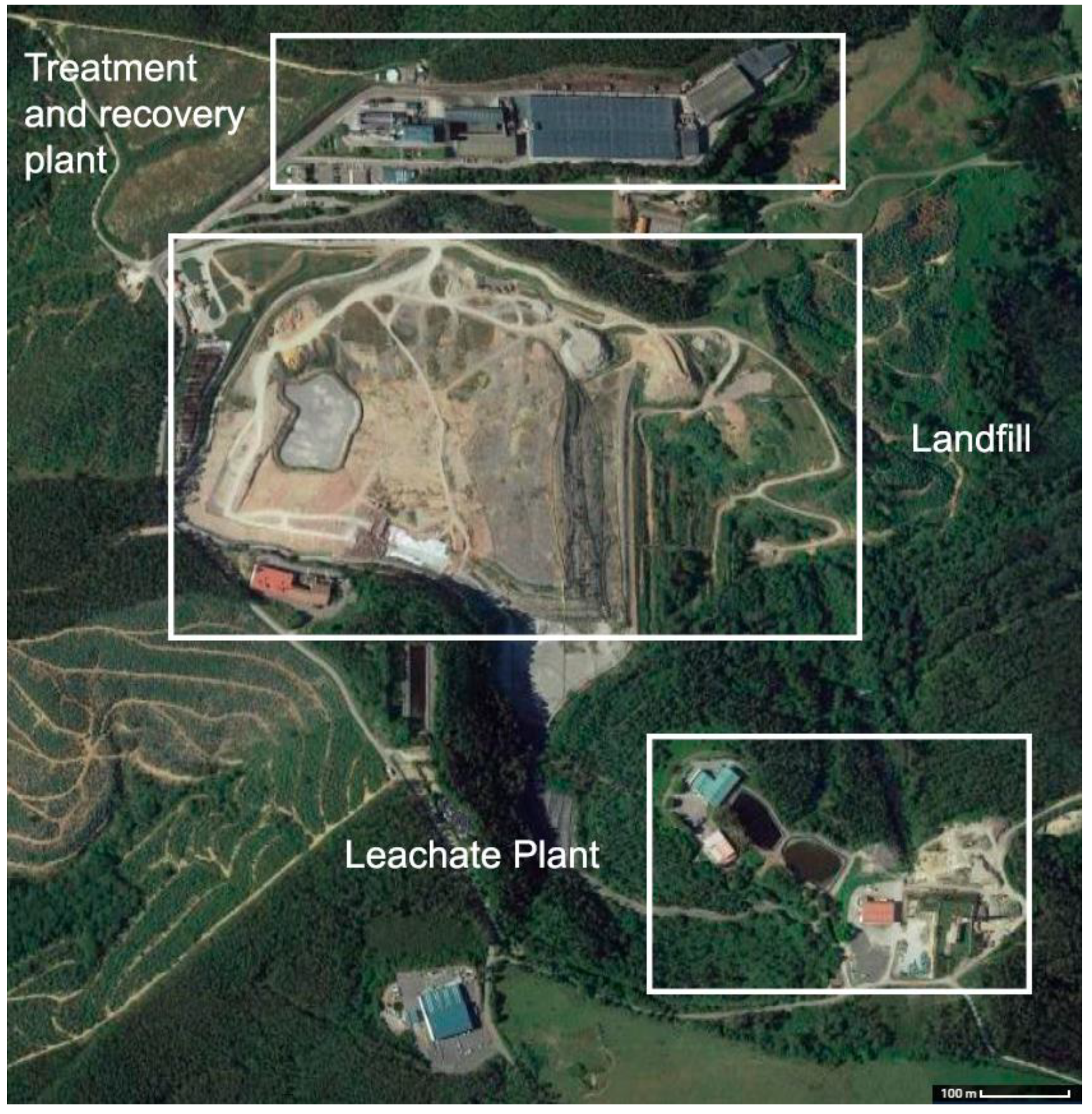

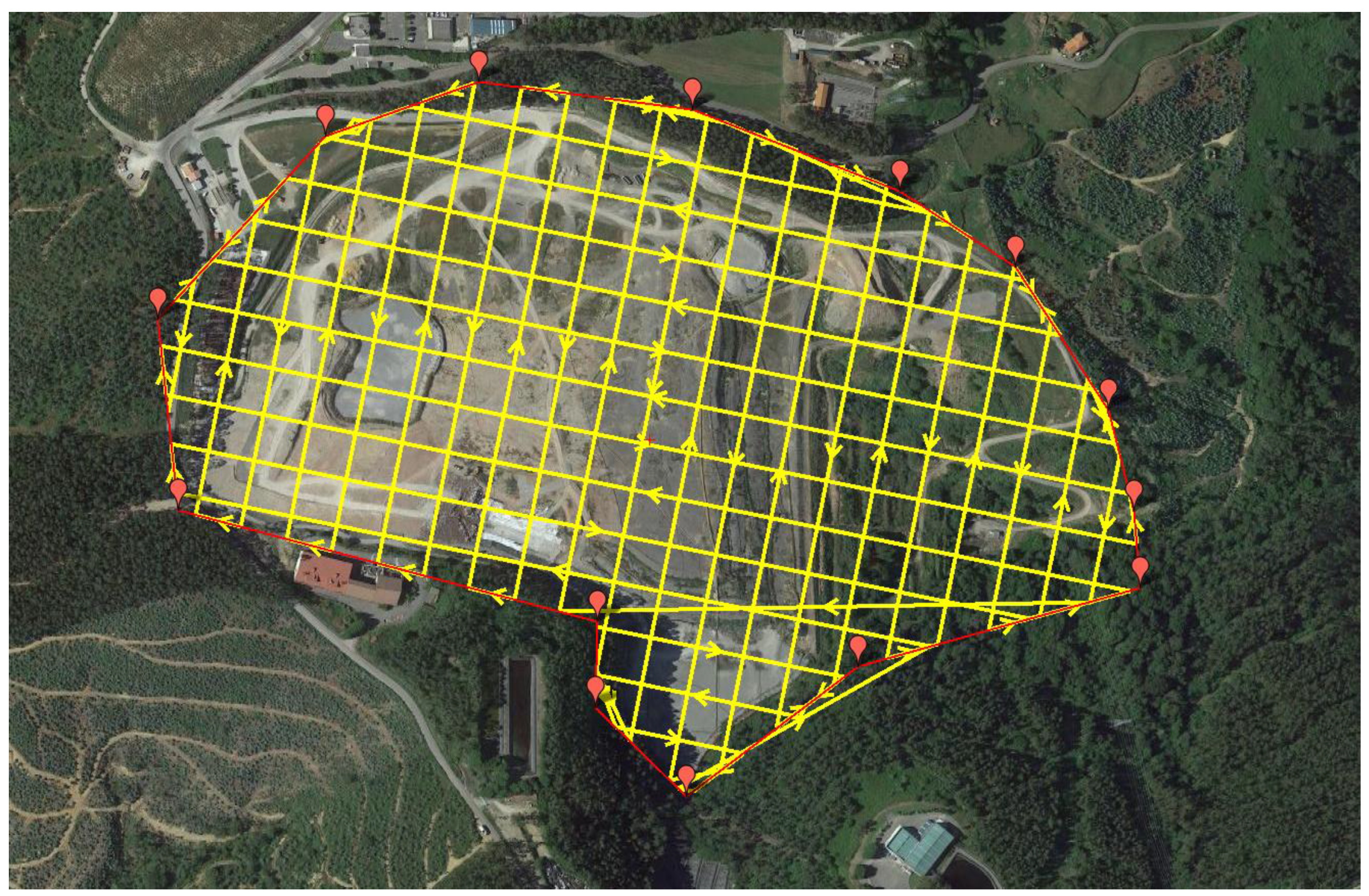
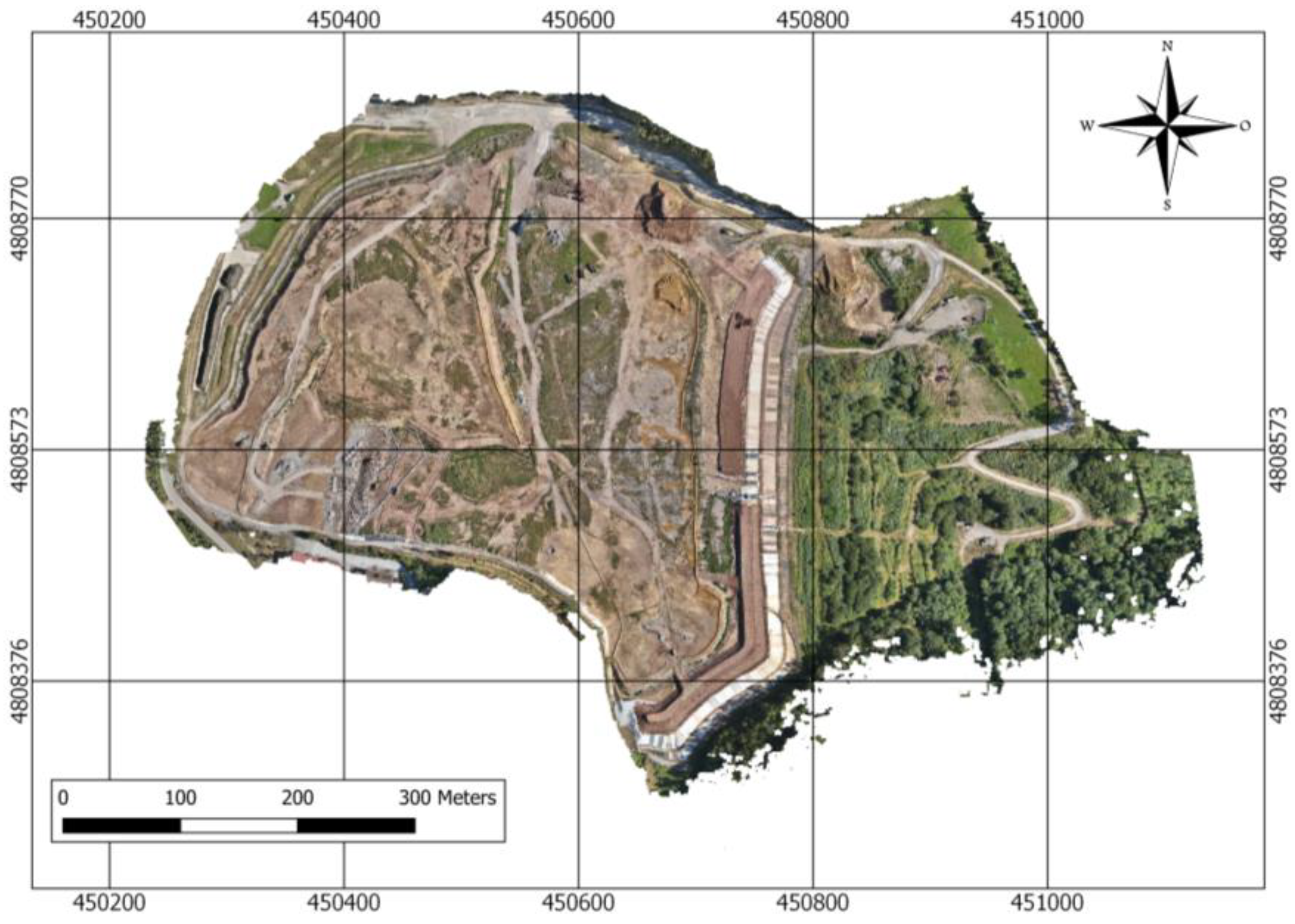





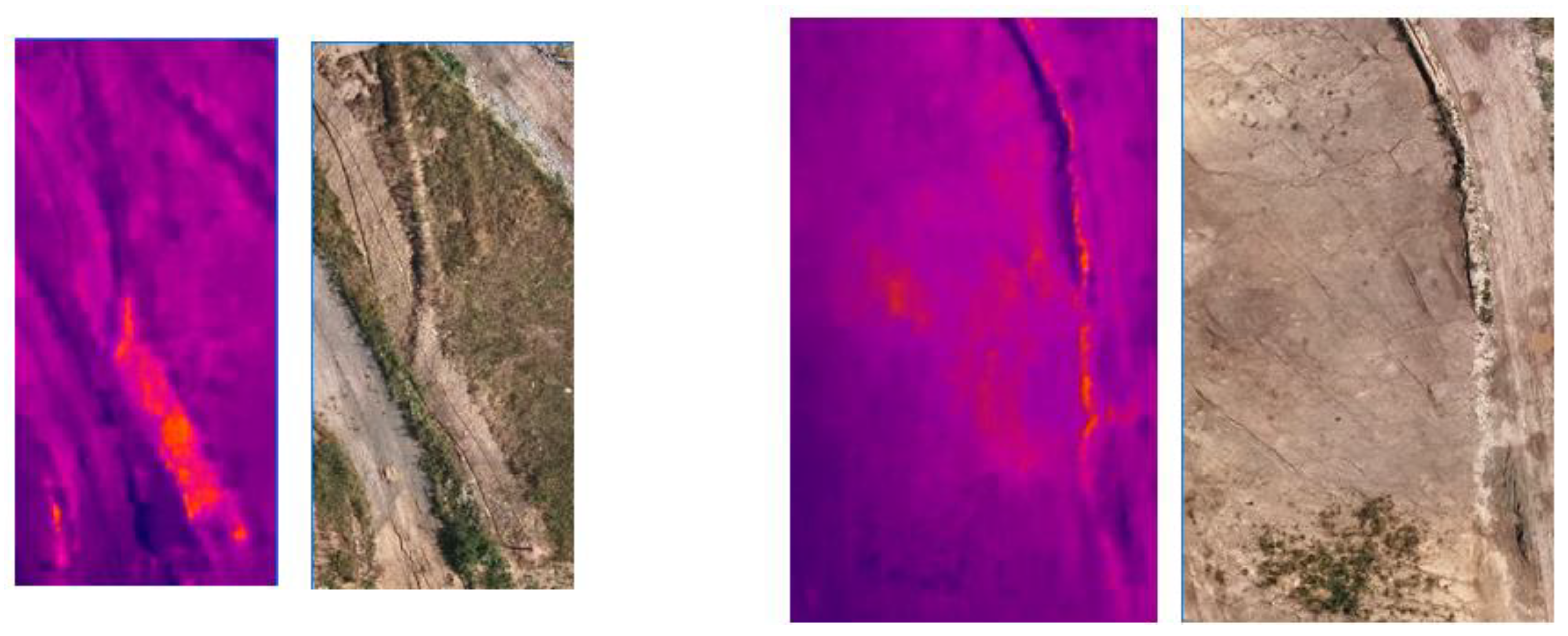
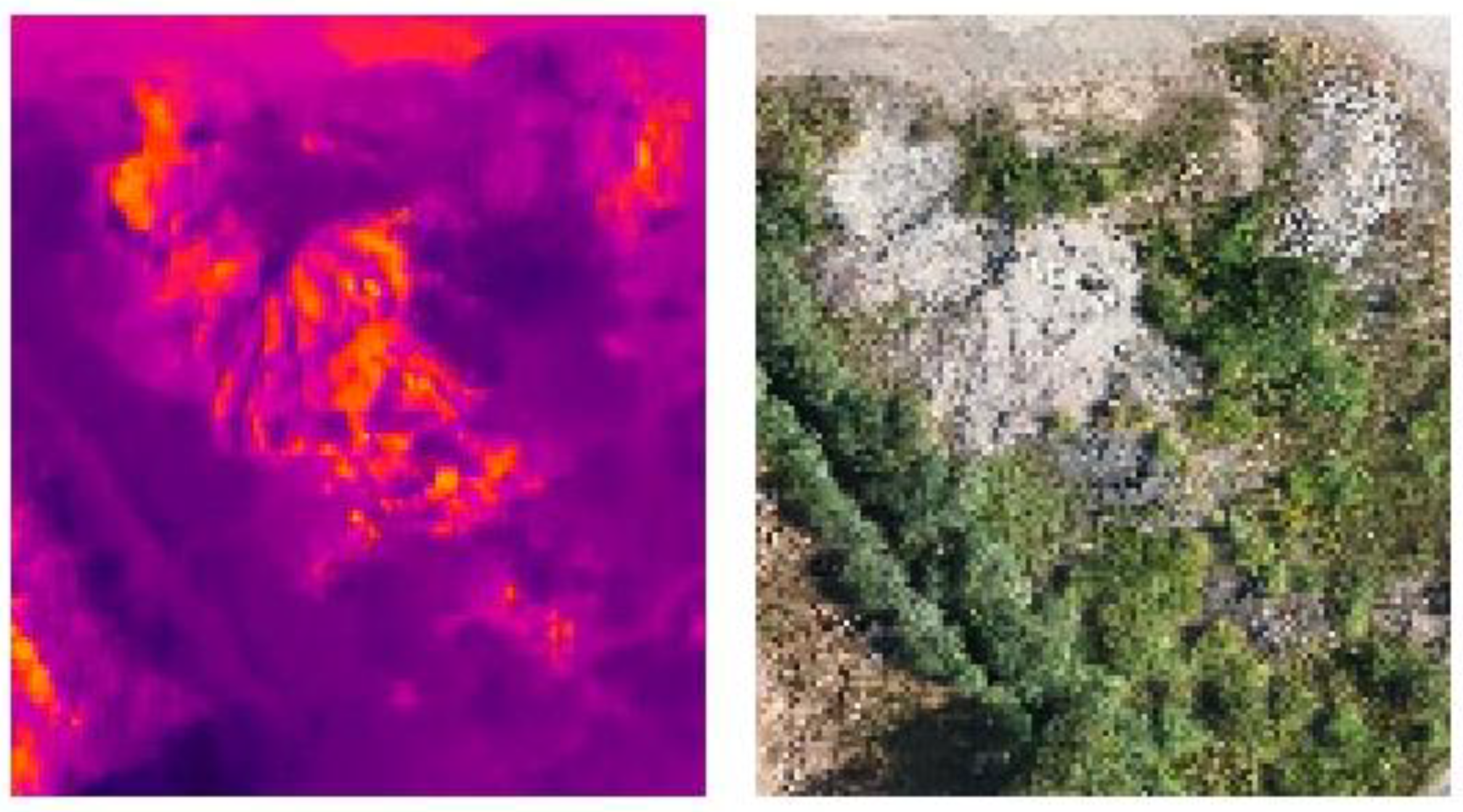
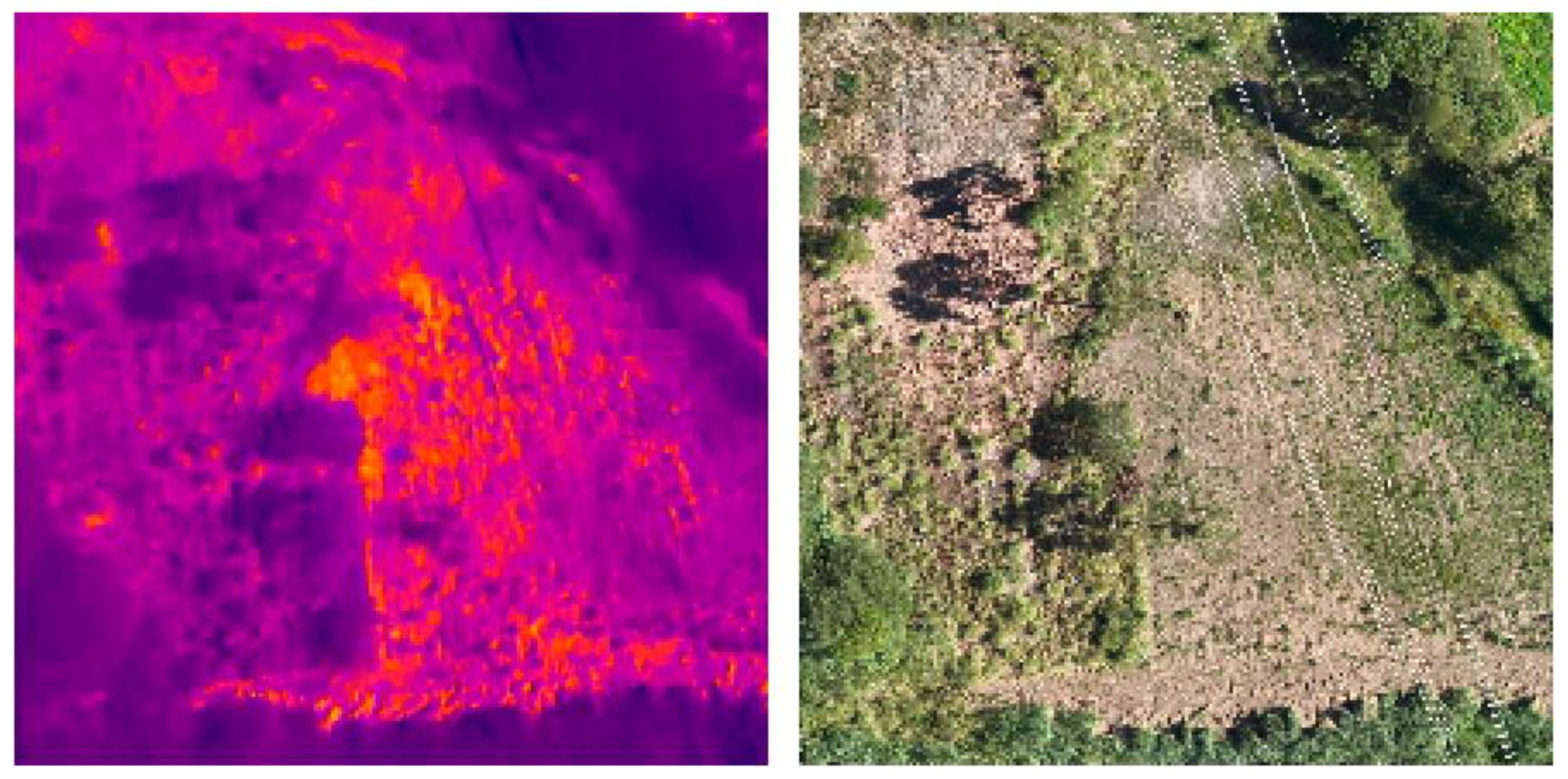
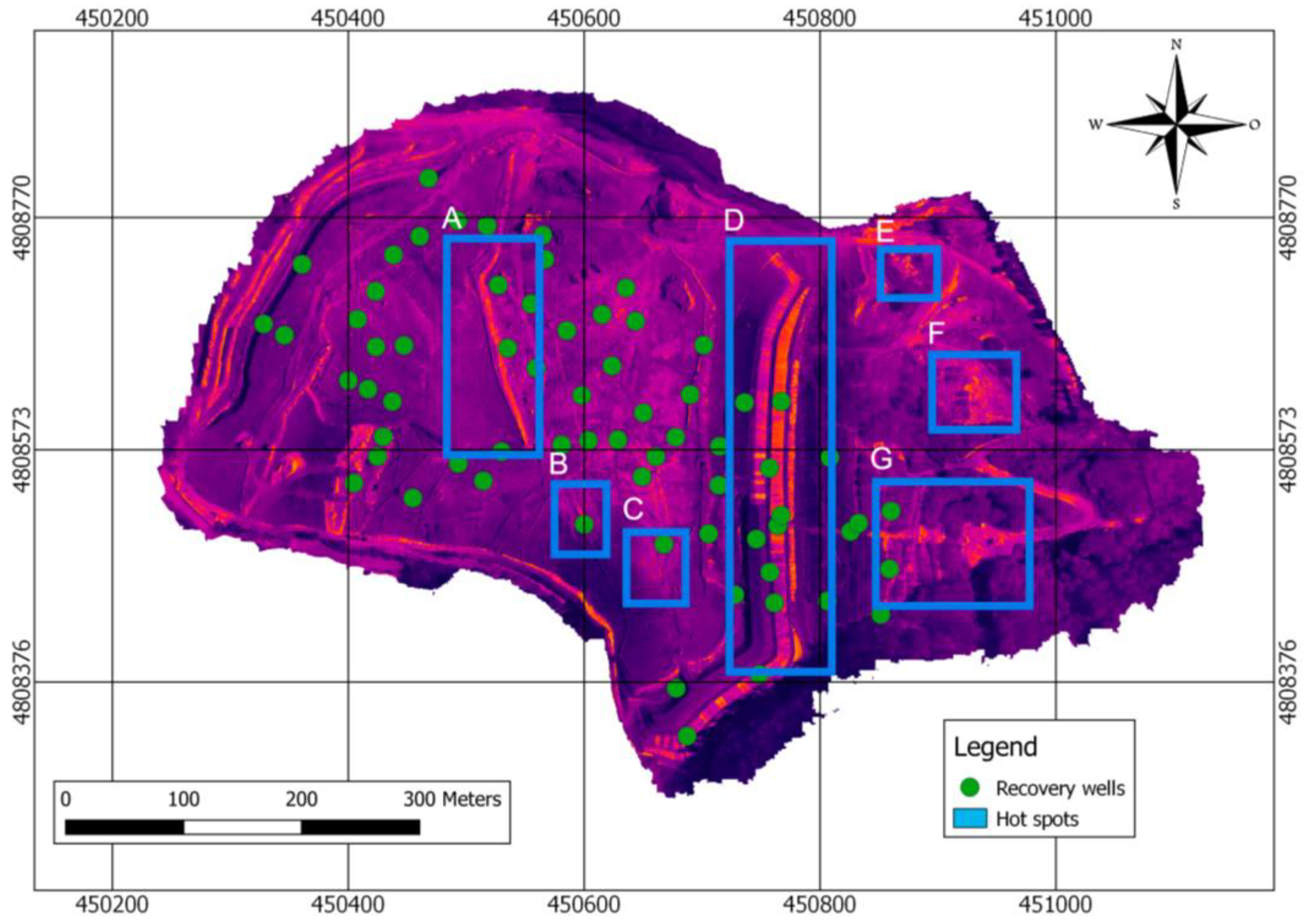
| Specifications | |
|---|---|
| Weight | 920 g |
| Dimensions | 347.5 × 283 × 107.7 mm |
| Autonomy | 45 min |
| Speed | 15 m/s |
| GNSS | GPS + Galileo + BeiDou + GLONASS |
| Specifications | |
|---|---|
| Sensor size | 1/2″ CMOS |
| Resolution | 4000 × 3000 px |
| Focal distance | 4.4 mm |
| Image format | JPEG |
| Specifications | |
|---|---|
| Sensor type | Uncooled Vox microbolometer |
| Resolution | 640 × 512 px |
| Spectral range | 8–14 µm |
| Accuracy | ±2 °C |
| Focal distance | 9.0 mm |
| Image format | JPEG, R- JPEG |
| Flight Parameters | |
|---|---|
| Height (m) | 100 |
| Speed (m/s) | 3 |
| Frontlap (%) | 80 |
| Sidelap (%) | 80 |
| Resolution (cm/px) | 4.77 (RGB) 10.71 (IR) |
| Number of photographs | 1289 |
| Flight time (min) | 87 |
Disclaimer/Publisher’s Note: The statements, opinions and data contained in all publications are solely those of the individual author(s) and contributor(s) and not of MDPI and/or the editor(s). MDPI and/or the editor(s) disclaim responsibility for any injury to people or property resulting from any ideas, methods, instructions or products referred to in the content. |
© 2023 by the authors. Licensee MDPI, Basel, Switzerland. This article is an open access article distributed under the terms and conditions of the Creative Commons Attribution (CC BY) license (https://creativecommons.org/licenses/by/4.0/).
Share and Cite
Sedano-Cibrián, J.; de Luis-Ruiz, J.M.; Pérez-Álvarez, R.; Pereda-García, R.; Tapia-Espinoza, J.D. 4D Models Generated with UAV Photogrammetry for Landfill Monitoring Thermal Control of Municipal Solid Waste (MSW) Landfills. Appl. Sci. 2023, 13, 13164. https://doi.org/10.3390/app132413164
Sedano-Cibrián J, de Luis-Ruiz JM, Pérez-Álvarez R, Pereda-García R, Tapia-Espinoza JD. 4D Models Generated with UAV Photogrammetry for Landfill Monitoring Thermal Control of Municipal Solid Waste (MSW) Landfills. Applied Sciences. 2023; 13(24):13164. https://doi.org/10.3390/app132413164
Chicago/Turabian StyleSedano-Cibrián, Javier, Julio Manuel de Luis-Ruiz, Rubén Pérez-Álvarez, Raúl Pereda-García, and Jonathan Daniel Tapia-Espinoza. 2023. "4D Models Generated with UAV Photogrammetry for Landfill Monitoring Thermal Control of Municipal Solid Waste (MSW) Landfills" Applied Sciences 13, no. 24: 13164. https://doi.org/10.3390/app132413164
APA StyleSedano-Cibrián, J., de Luis-Ruiz, J. M., Pérez-Álvarez, R., Pereda-García, R., & Tapia-Espinoza, J. D. (2023). 4D Models Generated with UAV Photogrammetry for Landfill Monitoring Thermal Control of Municipal Solid Waste (MSW) Landfills. Applied Sciences, 13(24), 13164. https://doi.org/10.3390/app132413164









